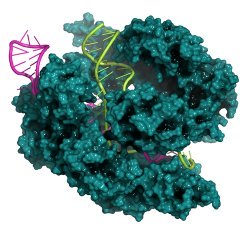Authors:
History:
 For a long time scientists have been dreaming of «correcting» genome, remove harmful mutations from it and prevent development of hereditary diseases. However, that became possible just a few years ago. There are three new technologies of genome editing. The earliest of them is the technology of zinc finger nucleases; the idea of this technology appeared as far back as 1980s.
For a long time scientists have been dreaming of «correcting» genome, remove harmful mutations from it and prevent development of hereditary diseases. However, that became possible just a few years ago. There are three new technologies of genome editing. The earliest of them is the technology of zinc finger nucleases; the idea of this technology appeared as far back as 1980s.
Example:
A while ago, research workers from the biotechnological company «Editas Medicine» announced at the scientific conference in Cambridge that they would be able to make pointwise changes in human genome by 2017.  Their creation was named «Clustered Regularly Interspaced Short Palindromic Repeats» (CRISPR). The experts predict that technology developed will help people get rid of many congenital diseases, e.g. congenital Leber amaurosis. That will be real breakthrough in medicine. Moreover, the scientists promise that their creation will be simple and cheap, so it will be open to specialists from all over the world.
Their creation was named «Clustered Regularly Interspaced Short Palindromic Repeats» (CRISPR). The experts predict that technology developed will help people get rid of many congenital diseases, e.g. congenital Leber amaurosis. That will be real breakthrough in medicine. Moreover, the scientists promise that their creation will be simple and cheap, so it will be open to specialists from all over the world.
Description:
Several technologies which allow to make directed changes in DNA nucleotide sequence of mammals were developed last years. At present, those new technologies are testing in mice:
 By the use of the method of TALEN nucleases, scientists make a break in the coding region of a gene and then they heal that break. In the experiments on mice, that technology was applied and mutation, that cause the development of one of the hereditary syndromes, was introduced into mouse genome. Then the authors of the experiment removed that mutation in the same way. Thus, they showed that TALEN allows changing genome efficiently.
By the use of the method of TALEN nucleases, scientists make a break in the coding region of a gene and then they heal that break. In the experiments on mice, that technology was applied and mutation, that cause the development of one of the hereditary syndromes, was introduced into mouse genome. Then the authors of the experiment removed that mutation in the same way. Thus, they showed that TALEN allows changing genome efficiently.
The method of zinc finger nucleases is not so effective as the methods mentioned above.
Methods of genome editing assure accurate delivery of therapeutic genes that allow retarding the processes of aging: telomerase reverse transcriptase (TERT), gene of the transcription factor FOXO3, and gene coding inhibitor of

Additions and Criticism:
Technologies described are not investigated and debugged enough. At the moment, careful modelling of those methods on mice is necessary. CRISPR and TALEN technologies are promising for the cure of serious illnesses of human.
Publications:
- Adam J. Bogdanove, Daniel F. Voytas. TAL effectors: customizable proteins for DNA targeting // Science. 30 September 2011.
v. 333. P. 1843–1846. Doi: 10.1126/science.1204094. -
Young Hoon Sung,
In-Jeoung Baek, Duk Hyoung Kim, Jisun Jeon, Jaehoon Lee, Kyunghee Lee, Daewon Jeong,Jin-Soo Kim &Han-Woong Lee. Knockout mice created byTALEN-mediated gene targeting // Nature Biotechnology. 2013.v. 31. v. 23 –24. Doi: 10.1038/nbt.2477. -
Kirill A. Datsenko, Ksenia Pougach, Anton Tikhonov et al. Molecular memory of prior infections activates the CRISPR/Cas adaptive bacterial immunity system // Nature Communications.
v. 3. Article number: 945. Published 10 July 2012. -
John van der Oost. New Tool for Genome Surgery // Science.
v. 339. P. 768–770